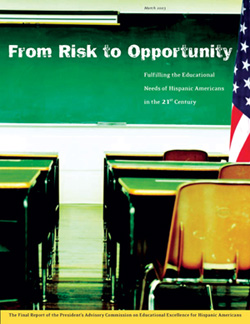From Risk to Opportunity
Fulfilling the Educational Needs of
Hispanic Americans in the 21st Century
Final Report submitted to President Bush
March 31, 2003
Background
 On October 12, 2001, President George W. Bush signed Executive Order 13230 charging a Presidential Advisory Commission with developing an action plan to close the educational achievement gap for Hispanic Americans. On October 12, 2001, President George W. Bush signed Executive Order 13230 charging a Presidential Advisory Commission with developing an action plan to close the educational achievement gap for Hispanic Americans.
The Commission's process was open and extensive. In 11 meetings and four unprecedented bilingual town hall forums, the Commission met with, talked to and listened to more than 1,600 experts, parents, teachers, students and business and community leaders.
On March 31, 2003, the Commission submitted to the President, From Risk to Opportunity, a plan to close the achievement gap for Hispanic American children.
Major Findings: The Present Crisis
In January 2003 the Census Bureau released new data showing that Hispanic Americans are now the largest minority group in the nation. Unfortunately, the Commission found that the nation is losing Hispanic American students all along the education continuum.
» One of every three Hispanic American students fails to complete high school.
» Only 10 percent of Hispanic Americans graduate from four-year colleges and universities, with fewer than 100,000 graduating each year.
» Too many Hispanic American families lack the knowledge to fulfill the high expectations they have for their children, and too many Americans set low expectations for them.
» The federal government does not adequately monitor, measure and coordinate programs and research to the benefit of Hispanic American children and their families, despite the rapidly growing Hispanic American population in the United States. (The nation's Hispanic American population totals more than 37 million and increased 4.7 percent from April 2000 to July 2001.)
Commission Recommendations: From Risk to Opportunity
The present crisis not only threatens to leave behind yet another generation of Hispanic children, it will limit their mobility in the labor force and could jeopardize our country's ability to compete economically. The crisis requires us ensure educational excellence for Hispanic Americans now. The Commission recommends six strategies.
1. Set New and High Expectations for Hispanic American Children.
Recommendation: Set new and high expectations across America for Hispanic American children by: helping parents navigate the educational system, creating partnerships that can provide expanded options for children, and implementing a nationwide public awareness and motivation campaign aimed at increasing educational attainment and achieving the goal of a college education.
2. Support No Child Left Behind.
Recommendation: The Commission strongly supports full implementation and full enforcement of No Child Left Behind. The Commission challenges the states and school districts to, within five years, increase the percentage of fourth graders reading at or above proficient on the National Assessment of Educational Progress by 30 percentage points and meet or exceed the annual measurable objectives defined in each respective state's accountability plan.
3. Reinforce and Expand a High-Quality Teaching Profession.
Recommendation: Reinforce a high-quality teaching profession by more fully preparing all teachers to address the diverse needs of their students, including Hispanics, those with disabilities and those with limited English proficiency by attracting more Hispanics to the teaching profession, and by providing incentives and compensation for successful performance as evidenced by improved student achievement. Launch a national study of the curricula, practica, student teaching experiences and the models used to integrate these preparation formats employed by colleges of education to prepare educators for reading instruction of diverse children.
4. Develop a Federal Research Agenda to Identify the Needs of Hispanic American Students.
Recommendation: Initiate a new coherent and comprehensive research agenda on the educational development of Hispanic Americans across the educational spectrum from preschool through postsecondary.
5. Create Pathways to College Graduation.
Recommendation: Ensure full access for Hispanic American students to enter college and demand greater accountability in higher education for Hispanic graduation rates. Challenge the nation's postsecondary institutions to graduate 10 percent more Hispanic American students from colleges and universities each year, than are currently graduating, over the next decade. Urge institutions to explore the increased development of retention programs that would benefit Hispanic American students.
6. Create Increased Federal Accountability and Coordination.
Recommendation: Increase the accountability and coordination of programs within the federal government to better serve Hispanic American children and their families.
The mission of the President's Commission, as set forth in the President's Executive Order 13230, is to achieve educational excellence for Hispanic Americans. The Commission, in meeting its obligations, aims to ensure that all children of Hispanic heritage, regardless of where they were born or when they came to this country, have the same opportunities for educational advancement, to realize the American dream, and to succeed.
# # #
 View Report in PDF Format View Report in PDF Format
|



 On October 12, 2001, President George W. Bush signed Executive Order 13230 charging a Presidential Advisory Commission with developing an action plan to close the educational achievement gap for Hispanic Americans.
On October 12, 2001, President George W. Bush signed Executive Order 13230 charging a Presidential Advisory Commission with developing an action plan to close the educational achievement gap for Hispanic Americans.